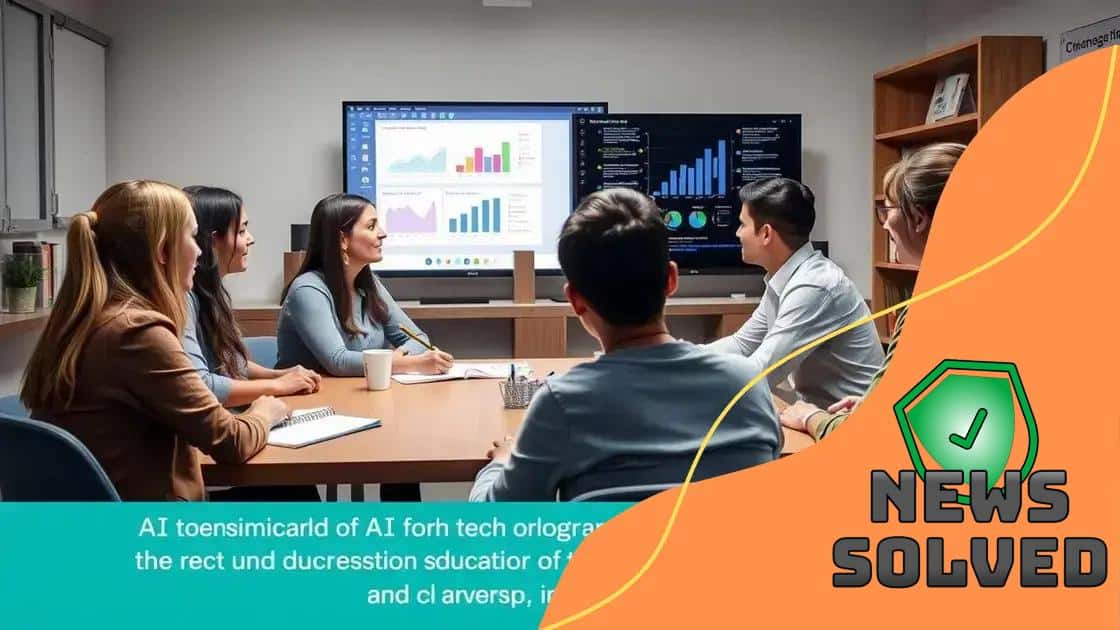The future of education through AI-based virtual classrooms

Advertisements
The future of education through AI-based virtual classrooms offers personalized and immersive learning experiences, enabling global collaboration and significantly enhancing student engagement and educational outcomes.
The future of education through AI-based virtual classrooms is reshaping how we teach and learn. Imagine a classroom where lessons adapt to each student’s pace and preferences. Intrigued? Let’s dive into how this technology is transforming education.
Advertisements
Understanding AI in education
Understanding AI in education is crucial to harnessing its full potential. This technology can dramatically change traditional learning environments and offer personalized experiences for students. With the help of artificial intelligence, educators can adapt their teaching strategies to meet the unique needs of each student.
How does AI work in classrooms?
AI systems analyze data from students’ interactions and performance. By assessing each learner’s strengths and weaknesses, these technologies can tailor lessons effectively.
Key advantages of AI in education
- Personalized learning experiences for students.
- Automated administrative tasks for teachers.
- Enhanced engagement through interactive technologies.
- Immediate feedback for students.
In addition, AI can help identify students who may need extra support. By monitoring progress and providing recommendations, educators can intervene early and help struggling students before they fall behind. The integration of AI also encourages collaboration among students, as they can work together in digital learning environments.
Advertisements
Furthermore, AI in education extends beyond mere academic support. It can help students develop essential skills like critical thinking and problem-solving. With tools that simulate real-world challenges, learners can practice applying their knowledge in practical scenarios.
Challenges of AI integration
Despite its advantages, implementing AI in classrooms presents challenges. Teachers may require training to effectively use these technologies. Additionally, there are concerns related to data privacy and the ethical implications of AI in education.
Ultimately, understanding AI in education opens doors to new possibilities. By embracing these innovations, schools can prepare students for a complex digital future.
Key benefits of virtual classrooms
Virtual classrooms offer many benefits that enhance the learning experience for both students and teachers. These innovative environments utilize technology to create interactive and engaging lessons.
Flexible learning opportunities
One of the key advantages of virtual classrooms is their flexibility. Students can learn from anywhere and at any time. This means they can access lectures and resources that suit their schedules. For instance, a student might review a recorded lesson while commuting or during a lunch break.
Access to diverse resources
Virtual classrooms provide access to a wide range of educational resources. Students can explore online libraries, educational videos, and even virtual field trips. This exposure broadens their understanding of different subjects and deepens their knowledge.
- Interactive tools for collaboration.
- Ability to engage with peers worldwide.
- Access to expert guest speakers from various fields.
- Customized learning paths based on individual student needs.
Additionally, these platforms foster collaboration among learners. By connecting with peers across the globe, students can share ideas and perspectives that enhance their learning. This global community encourages skills like teamwork and communication.
Moreover, virtual classrooms utilize data analytics to track student performance. Educators can identify areas where students struggle and provide targeted support. This is another way to personalize education, ensuring all students receive the help they need to succeed.
Cost-effectiveness
Virtual classrooms can also be more cost-effective than traditional schooling. Schools can save on expenses related to physical space, commuting, and printed materials. These savings can be redirected towards improving technology and resources for students.
In conclusion, the key benefits of virtual classrooms significantly transform education. With flexibility, access to diverse resources, collaboration opportunities, and cost savings, they pave the way for a more effective learning environment.
Challenges in implementing AI technology

Implementing AI technology in education comes with several challenges. While it holds great promise, understanding these obstacles is essential for successful integration.
Lack of training for educators
One major challenge is the lack of training for teachers. Many educators feel unprepared to use AI tools effectively. Without proper training, they may struggle to integrate technology into their lesson plans.
Data privacy concerns
Data privacy is another critical issue. Schools collect a vast amount of information about students to personalize learning. This data must be protected to prevent misuse. Parents and educators alike worry about how their data is stored and used.
- Understanding legal requirements for data protection.
- Ensuring secure storage of sensitive information.
- Establishing clear policies on data usage.
- Building trust with students and parents regarding privacy.
Moreover, the cost of implementing AI technology can be prohibitive. Schools may face budget constraints that limit their ability to purchase the necessary tools and technology. Additionally, ongoing maintenance and updates create further financial burdens.
Resistance to change also affects AI adoption. Some educators prefer traditional teaching methods and might be hesitant to embrace new technologies. This resistance can hinder progress and limit the benefits that AI can bring.
Technological infrastructure
An inadequate technological infrastructure can pose significant barriers. Schools must have reliable internet access and up-to-date devices to implement AI successfully. Without this foundation, students may not be able to leverage the learning tools effectively.
The integration of AI technology in education is exciting but complex. Understanding these challenges is vital for creating a supportive environment that can maximize the benefits of this innovative approach.
Examples of successful AI-based classrooms
There are many inspiring examples of successful AI-based classrooms that demonstrate the potential of technology in education. These innovative environments show how schools can enhance learning experiences for students.
Adaptive Learning Systems
One notable example is the use of adaptive learning systems. These programs, like Knewton and DreamBox, personalize educational content based on a student’s learning pace and style. By analyzing data, they adjust the difficulty of tasks, helping students master subjects more effectively.
AI-Powered Tutoring
Another success story is AI-powered tutoring. Platforms like Coursera and edX incorporate intelligent tutoring systems that provide instant feedback and assistance. Students can ask questions and receive tailored explanations, allowing for a more interactive and engaging learning process.
- Automated grading systems, saving teachers time.
- Virtual assistants that help with organization and reminders.
- Gamification elements to enhance student motivation.
- Data analytics that inform teaching strategies.
Some schools have integrated AI-driven technologies into their lesson plans. For example, in some districts, teachers use AI tools to create interactive lessons and track student progress in real time. These tools can identify which students need more help, enabling targeted support.
Moreover, AI is being utilized to enhance classroom management. Tools like Classcraft gamify behavior management, allowing students to earn rewards for positive actions. This approach creates a fun learning environment while teaching responsibility.
Global Collaborations
Finally, successful AI-based classrooms often incorporate global collaborations. Schools can connect students from different parts of the world through virtual exchange programs. This exposure not only enriches students’ learning experiences but also helps them develop cultural awareness and empathy.
These examples showcase the versatility and effectiveness of integrating AI into education. The potential benefits are immense, providing students with personalized, engaging, and interactive learning experiences.
The future landscape of learning with AI
The future landscape of learning with AI promises to reshape education in exciting ways. As technology evolves, so do the possibilities for student engagement and personalized learning.
Personalized Learning Experiences
In the coming years, we can expect an increase in personalized learning experiences. AI will analyze student data to create tailored educational paths. This means that each learner will progress at their own pace, receiving content that suits their individual strengths and weaknesses.
Virtual Reality and Augmented Reality
Moreover, virtual reality (VR) and augmented reality (AR) integrated with AI will enhance immersive learning experiences. Imagine students exploring ancient civilizations through VR or conducting science experiments in a 3D environment. These tools make learning more engaging and interactive, helping students visualize complex concepts.
- Increased use of gamification to motivate students.
- Enhanced collaboration in virtual classrooms.
- Access to global learning communities.
- Continuous assessment for immediate feedback.
Instruction will also be more collaborative, allowing students to work together from various locations. They will access resources and interact with peers and educators worldwide. This global perspective will foster cultural awareness and understanding.
Another aspect of the future landscape will include the rise of AI-driven administrative tasks. Teachers will spend less time on grading and paperwork, allowing them to focus more on teaching. This efficiency can lead to more effective classroom management and improved student-teacher interactions.
Ethical Considerations
However, with advancements come certain ethical considerations. As AI becomes more integrated into learning, there will be discussions around data privacy and security. Ensuring that students’ personal information is protected will be paramount.
In summary, the future of learning with AI is bright. With personalized experiences, immersive technologies, and less administrative burden, education can become more effective and engaging for everyone involved.
FAQ – Frequently Asked Questions about AI in Education
How does AI personalize the learning experience for students?
AI analyzes individual student data to tailor educational content and pacing, ensuring each learner gets the support they need.
What role will virtual reality play in future classrooms?
Virtual reality will allow students to engage in immersive learning experiences, exploring subjects like history and science in 3D environments.
What are the main ethical concerns about AI in education?
The primary concerns include data privacy, security of student information, and ensuring equitable access to AI technologies.
How can teachers utilize AI to enhance their teaching methods?
Teachers can use AI tools for grading, creating interactive lessons, and gaining insights into student performance to improve instructional strategies.





